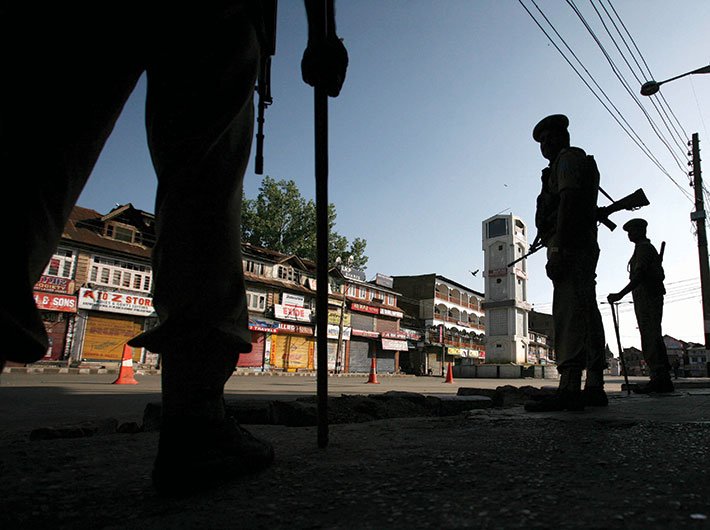The imagery of Kashmir is heart-breaking: children with swollen faces and closed eyes lying on hospital beds, women wailing over their dead men, angry mourners accompanying the dead for burials and security men clashing with stone-pelting mobs – all for one person, Burhan Wani, the Hizbul Mujahideen commander who, in his death, proved to be the biggest troublemaker in the recent times. In the fortnight after his death, 49 people are dead and scores with pellet injuries are being treated in hospitals with many facing grim prospect of losing their vision.
For all his sins, Wani was a minor, only 15 years old, when he picked up the gun. Like other teenagers, he too must have started as a rebel with a hazy idea of his cause. His environs – a father who owed allegiance to Jamiat-e-Islami, which is a Muslim equivalent of RSS in Kashmir; his brother’s apparent mistreatment by the army – were factors that probably turned him into a gun-toting rebel.
But in Burhan’s short life story, there is a lesson for those handling Kashmir and those avoiding taking up responsibility of making peace return to the valley. Firstly, the security forces – Rashtriya Rifles, which is a para-military wing of the army, CRPF and the J&K police – have to do soul-searching to understand why the mass protests post-Wani should make them rethink on the counter-insurgency strategy. Though spewing opinions on Kashmir’s counter-insurgency on TV channels and social media is fashionable, it remains a hard fact that insurgency has to be fought till the last gun remains in Kashmir; the path can be tragic but is simply unavoidable.
Let’s be clear that it is only due to a relentless pursuit of terrorists by the forces that today Kashmir is no longer a favourite haunt of Pakistan-trained terrorists. Compared with the past one and a half decade, today there is only a trickle that is being pushed into Kashmir via the line of control (LOC). People who have lived in Kashmir in the nineties would recall how Srinagar, the epicentre of insurgency then, used to reverberate with gunfire all night. The police control room strip in the evening would, on an average, list 10 major encounters between the forces and militants. All that has changed and today the forces are into precise encounters, which, without doubt, are facilitated by intelligence given by the locals.
On the other side, like Burhan Wani, a generation of Kashmiris has grown up after 1989, the year insurgency started in a big way in Kashmir with the sudden rise of JKLF. This generation wishes to lead a normal life, pursue careers and passions. They do not carry the baggage of the Kashmiri Pandits’ exodus nor do they have any ideological commitment to Pakistan or terrorist organisations, for they have seen enough bloodshed around them. Not many know of a neighbourhood militant commander to romanticise gun and gore.
However, the security forces are yet to take cognisance of the changed ground situation; they continue to pursue same old ways to control insurgency like, for example, subjecting young Kashmiris to frisking, question, and even detention anytime and anywhere. This is humiliating and obviously makes their blood boil. To add insult to their injury, many Kashmiri students have faced the wrath of vigilante groups within campuses outside the state.
This is why a sea of young men was seen at Burhan’s funeral and also in the subsequent violent protests in his home turf of south Kashmir. Burhan came across as someone who was angry at the frisking and mistreatment of his brother at the hands of the army. His use of Facebook and other social media sites made the younger Kashmiris connect to empathise with him. Honestly, except for killing two hapless sarpanches, Burhan has no record of military prowess and was more of a social media tiger. On his Facebook posts, where he would try to inspire youth to join insurgency, he also gave away his inexperience and age. However, a generation saw him as a crusader against an evil India.
Frankly, In Kashmir, time has come for the forces to stop random frisking or it would continue to create bad blood and prove counterproductive. Winning over the younger generation is key to ending insurgency. Towards this, while government can offer them jobs and entrepreneurship opportunities, the forces must restore their dignity. A nation which drives its young ones to desperation can never succeed.
The violence should shame us, as a nation, about our incorrigible ways. Why should the forces be still using the deadly pellet guns to disperse violent mobs after the experience of 2010 riots which left more than 100 youth dead. Ironically the pellet guns had been introduced as replacement for guns and rubber bullets after the 2010 experience. The damage caused by this supposedly non-lethal weapon has been devastating – even five-year-olds have become its victims. On top of it, home minister Rajnath Singh has set up a mammoth committee to decide what the pellet gun should be replaced with. Frankly, he makes it sound like seeking advice on another mangalyaan project. Hasn’t North Block heard of water cannons and rubber bullets? Such tactics no longer impress people these days.
Secondly, the role of local politicians in countering propaganda unleashed by terrorists and their masters in Islamabad leaves much to be desired. Most of them believe that it is the army’s job to end terrorism and they have been elected just to manage the day-to-day matters of governance. Some feel that it’s an India-Pakistan proxy war and therefore let things be handled by New Delhi and Islamabad. We must remember that most Kashmiri mainstream and even separatist politicians are protected by high-security network at the cost of the exchequer. Be it the National Conference or the PDP, the two regional parties with a strong base in Kashmir, their leaders often play to the galleries when it comes to taking stand against terrorists. In 2010, the then opposition leader Mehbooba Mufti had scored brownie points over the Omar Abdullah government by pinning all the blame on its doors for killing of a boy called Tuffail Matoo, which had set off a long spell of violence. The unrest was a major factor behind Abdullah’s defeat in 2014 elections. Politicians being politicians, today Omar is not refraining from blasting the beleaguered Mehbooba Mufti for the post-Burhan violence.
Omar didn’t even join the all-party meet convened by Mehbooba to forge a common political response to the perpetrators of violence. How we wish Kashmiri leaders rise above petty politicking and play a pro-active role in countering the ideology of terrorism. Army can only eliminate the terrorists but not kill the idea behind this creed.
aasha@governancenow.com
(The column appears in the August 1-15, 2016 issue)

